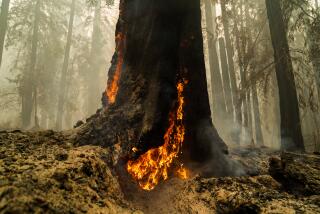Review: In âWhite Beech,â Germaine Greer finds a forest with a view
In her 1999 book âThe Whole Woman,â a follow-up to âThe Female Eunuch,â Germaine Greer declared, âItâs time to get angry again.â She was addressing feminism, about which she has long been rigorous and even unorthodox, but the phrase is emblematic of her entire worldview. For Greer, complacency is our most pressing problem, not just in the sense of doing nothing but also in terms of doing the wrong thing.
âTechnology has no solutions to the problem of biodepletion,â she writes in âWhite Beech: The Rainforest Years.â âThere is little point in accumulating gene banks and none whatever in breeding threatened species in captivity. The only way of keeping the extraordinary richness and exuberance of this small planet is to rebuild habitat.â
âWhite Beechâ is Greerâs 11th book, and it initially appears to be a departure: the story of a decade spent developing the Cave Creek Rainforest Rehabilitation Scheme on a 60-hectare (about 150-acre) former dairy farm in the northeastern Australian state of Queensland, where she put her habitat-rebuilding theories to the test.
For Greer, this was an unexpected move â âan extraordinary stroke of luck,â she calls it â but not exactly out of character, for she has always been equally hard-edged and utopian. Thatâs the key to both her feminism and her other political activism, and so the decision to spend half a million dollars to purchase a devastated corner of the Gondwana Rainforests system is very much in keeping with her sensibility.
âI was sixty two,â Greer writes, âwhen the forest became my responsibility, with no idea of how long I might be able to go on earning a living by my pen and my tongue. Our culture is not sympathetic to old women, and I was definitely an old woman, with a creaky knee and shockingly arthritic feet. Everyone else my age was buying a unit on the Sunshine Coast. What did I think I was doing buying sixty hectares of steep rocky country, most of it impenetrable scrub?â
The answer, she continues, was that she wasnât thinking; she was acting, responding to her instincts, following âa series of signs and portents that led beyond thought, to find myself in a realm that was unimaginably vast and ancient. My horizons flew away, my notion of time expanded and deepened, and my self disappeared.â
This is gorgeous writing, personal and heartfelt, and it suggests the connection Greer found at Cave Creek, the feeling that she had found her place. âI didnât fall in love with native Australian vegetation until I was middle-aged,â she acknowledges, âand then I fell hard, as middle-aged women do.â
To Greer, that word ânativeâ is essential, since much of the work she describes here involves identifying, and then removing, invasive plant species to return her freehold to a more protean state. These include morning glory and Madeira vine and shrubs like lantana, which was âdeliberately imported, propagated and planted ⌠[and] now covers 4 million hectares in eastern Australia.â
Each year, Greer and her co-workers remove âtons of Lantana with chainsaws and brush hooksâ from the steep slopes of Cave Creek. âLantana needs sun,â she explains; âonce our little trees are high enough to cast shade, Lantana is no threat at all. What is more, if the canopy is restored, none of the other weed species associated with Lantana will take over the space that it has vacated. The message is simple: if you want to eliminate Lantana, restore the forest. Nothing else will work.â
What Greer is arguing for is a kind of environmental absolutism. In her view, the country, the planet even, is not beyond saving, but only if we open up our way of thinking. We need to know more, so we can understand where we are and how to move ahead. To highlight this, she spends much of the book crafting a series of capsule histories â of the ecosystem, the settlement of Cave Creek, the timber industry, Australian botany â that offer context that is both immediate and longer term.
âEvery day, as we write labels for the boxes where we sow our freshly gathered seed, we do homage to dead white men,â she writes, a deftly ironic double entendre meant to comment on both her efforts at propagation and the hegemony of generic names for plant life.
A similarly pointed bit of humor emerges in her account of the discovery, in 1893, on what would later be her property, of the biggest cedar anyone had then seen. âConfronted with this botanical marvel,â she writes of the two men who found the tree, âthe only thing they could think to do was cut it down.â The joke, however, was on them; sent to the Crystal Palace in London, where it was to be displayed âfor perpetuity,â the tree was destroyed when the structure burned in 1936.
âPerpetuity,â Greer notes with icy satisfaction, âis not what it used to be.â
What Greer is saying is it is not posterity that defines us but rather history â history as continuum, in which the future is not open-ended but an extension of the past. âThis book must end,â she writes, âbut the story will continue,â an obvious point, perhaps, but one that reminds us of the need to see beyond our own lives.
âWhite Beechâ has such a notion encoded at its center; it is named for a tree indigenous to the Cave Creek region, the âwanton destructionâ of which a century ago by the timber industry becomes an especially potent metaphor. Like the rain forest it describes, it can be dense in places, less a memoir than a piece of natural (and cultural) history, but that sense of engagement, of (no pun intended) deep roots, is also one of its charms.
âExpect nothing from people,â Greer insists, âand you will get nothing.â Give them information, though, and perhaps they will get angry enough (again) to make a change. âThe process by which the forest is being given back to itself,â she concludes, âis complicated and drawn-out, but now that it has begun a great wrong is on its way to being righted. The stupendous phenomenon that is the forest will have time and space to come into its own again.â
Twitter: @davidulin
White Beech
The Rainforest Years
Germaine Greer
Bloomsbury: 370 pp., $30
More to Read
Sign up for our Book Club newsletter
Get the latest news, events and more from the Los Angeles Times Book Club, and help us get L.A. reading and talking.
You may occasionally receive promotional content from the Los Angeles Times.








